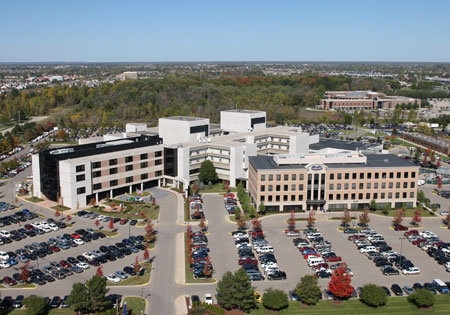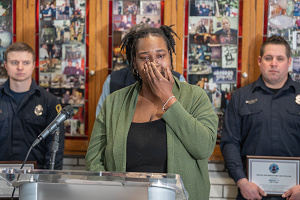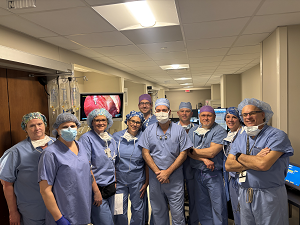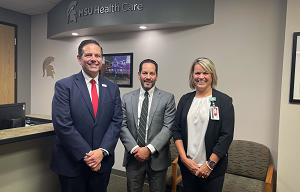Study: Catheter-based TAVR Heart Procedure Better Than Aortic Valve Surgery

TAVR Trial at Henry Ford and Other Hospitals Means Recommendation Shift
NEW ORLEANS – Many patients who need a new aortic heart valve can have it safely implanted through a catheter rather than open heart surgery, say study results announced today at the American College of Cardiology’s Annual Scientific Sessions in New Orleans.
“This isn’t just a paradigm shift; it’s a complete flip on its edge,” said Dr. Janet “Gigi” Wyman, nurse practitioner and manager of the Henry Ford Center for Structural Heart Disease. Dr. Wyman was part of the panel responding to Sunday’s announcement at the largest annual gathering of cardiologists in the world. The results were also published today in the New England Journal of Medicine.
The Partner-3 trial results announced today compared transcatheter aortic valve replacement, or TAVR, in low-risk patients with symptomatic severe aortic stenosis to patients who underwent surgery. The trial involved 1,000 patients – including patients at Henry Ford Hospital – and was led by Columbia University cardiologist Martin B. Leon. The trial results showed TAVR was superior to SAVR at reducing death, stroke, or re-hospitalization at 1 year in low-risk patients.
Dr. William W. O’Neill, director of the Henry Ford Center for Structural Heart Disease, in 2005 was the first cardiologist to perform TAVR in the United States. The procedure – using a catheter through the groin to replace a defective aortic valve – was first performed in France in 2002.
The U.S. Food and Drug Administration, which regulates medical innovation in the United States, initially limited TAVR to high-risk patients who were too sick to undergo surgical aortic valve replacement, or SAVR. TAVR’s initial success led the FDA to commercially approve TAVR in high-risk patients in 2012 and allow studies to proceed in medium- and low-risk patients.
“When I saw news of the first TAVR ever, the medical skeptic in me thought ‘This will never work,’” Dr. Wyman said. “TAVR will now eventually become the first choice for aortic valve repair and replacement for the vast majority of patients. This is going to mean a seismic shift in our approach to discussions with patients, internal operations and future planning.”
Although the trial for low-risk patients is complete, FDA approval is still pending for TAVR to be commercially available for low-risk patients, she added.
Patients in the Partner-3 study had a mean age of 73 and were experiencing symptoms of advanced aortic stenosis, including shortness of breath, chest pain, fainting or palpitations. Those who underwent TAVR, which avoids a large chest incision, were suitable for access through a blood vessel in the groin and had a low risk for complications. Patients who were frail, had a bicuspid valve or left ventricular ejection fraction of less than 30%, recently experienced a heart attack or had other medical issues were excluded. The patients were randomized 1:1 for surgical or catheter-based valve replacement with a SAPIEN-3 valve manufactured by Edwards LifeSciences.
One year after their procedure, approximately 8.5% of TAVR patients experienced death, stroke or re-hospitalization, compared to 15.1% of surgical patients. TAVR patients often spent less than 24 hours in the hospital then returned quickly to normal life, compared to days of hospitalization and weeks of recuperation for those who underwent surgery.
Studies estimate about 12.4% of people in the United States have aortic stenosis, with 3.4% of those being severe and needing treatment. Henry Ford Health System’s Center for Structural Heart Disease is a leading valve repair and replacement center in the Midwest, offering the most devices, both FDA-approved and investigational, available for patients.
“With our aging population and the continued refinement of our techniques and devices, use of this technology will only continue to expand to the benefit of our patients,” said Dr. Henry Kim, Medical Director of the Edith and Benson Ford Heart & Vascular Institute, on Sunday from New Orleans shortly after the announcement. “Bill O'Neill was prescient of this revolution in how we treat structural heart disease. Now, our large, experienced team and state-of-the-art center is poised to treat all patients in need of a new valve.”
The Henry Ford Center for Structural Heart Disease is a magnet referral center in the Midwest for patients with valve issues, including treatment of aortic and mitral valves. The Center includes multiple heart catheterization laboratories, including two hybrid catheterization lab and operating rooms, or Hybrid ORs, at Henry Ford Hospital and one Hybrid OR at Henry Ford Macomb Hospital in Clinton Township. Patients who undergo TAVR typically go home within 24 hours. These patients can experience concierge-level care, with hotel-like surroundings for them and their loved ones. TAVR Clinics are available at Henry Ford Macomb Hospital and Henry Ford Allegiance Hospital in Jackson – with TAVR procedures expected to be available at both hospitals with the Henry Ford team within the next few months.
###
MEDIA CONTACT: Tammy Battaglia / TBattag1@hfhs.org / 248-881-0809
.svg?iar=0&hash=F6049510E33E4E6D8196C26CCC0A64A4)

/hfh-logo-main--white.svg?iar=0&hash=ED491CBFADFB7670FAE94559C98D7798)









